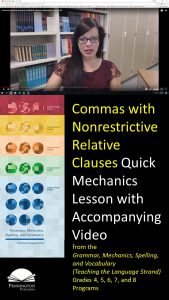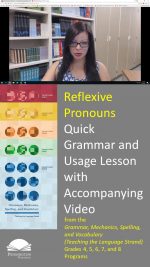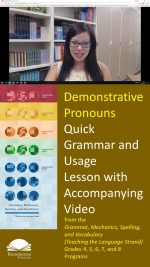Commas with Nonrestrictive Relative Clauses
Commas with Nonrestrictive Relative Clauses
Play the quick video lesson HERE and click the upper left back arrow to return to this lesson.
Common Core Language Standard 2
Since restrict means to keep within certain limits or to not allow beyond a certain area, then opposite meaning must mean to allow outside of certain limits or permit beyond a certain area. In mechanics we have to show that these words and meanings are not limited within the clause and so we use punctuation.
Today’s mechanics lesson is on how to use commas with nonrestrictive relative clauses. Remember that a clause has a noun and a connected verb.
Now let’s read the mechanics lesson and study the examples.
The relative pronouns who, whom, whose, and which, but not that, begin nonrestrictive relative clauses. Use commas to set off nonrestrictive relative clauses from the noun or pronoun before the clause. Example: The girl, who sits in the corner, is sleepy.
Now circle or highlight what is right and revise what is wrong according to mechanics lesson.
Practice: The politician, who promised to fix the economy, who pledged to lower taxes and who swore to protect the environment, was defeated soundly at the polls.
Let’s check the Practice Answers.
Mechanics Practice Answers: The politician, who promised to fix the economy, who pledged to lower taxes,and who swore to protect the environment, was defeated soundly at the polls.
Now let’s apply what we have learned.
Writing Application: Write your own sentence using a nonrestrictive relative clause in the middle of the sentence.
*****

Pennington Publishing Grammar Programs
Teaching Grammar, Usage, and Mechanics (Grades 4, 5, 6, 7, 8, and High School) are full-year, traditional, grade-level grammar, usage, and mechanics programs with plenty of remedial practice to help students catch up while they keep up with grade-level standards. Twice-per-week, 30-minute, no prep lessons in print or interactive Google slides with a fun secret agent theme. Simple sentence diagrams, mentor texts, video lessons, sentence dictations. Plenty of practice in the writing context. Includes biweekly tests and a final exam.
Grammar, Usage, and Mechanics Interactive Notebook (Grades 4‒8) is a full-year, no prep interactive notebook without all the mess. Twice-per-week, 30-minute, no prep grammar, usage, and mechanics lessons, formatted in Cornell Notes with cartoon response, writing application, 3D graphic organizers (easy cut and paste foldables), and great resource links. No need to create a teacher INB for student make-up work—it’s done for you! Plus, get remedial worksheets, biweekly tests, and a final exam.
Syntax in Reading and Writing is a function-based, sentence-level syntax program, designed to build reading comprehension and increase writing sophistication. The 18 parts of speech, phrases, and clauses lessons are each leveled from basic (elementary) to advanced (middle and high school) and feature 5 lesson components (10–15 minutes each): 1. Learn It! 2. Identify It! 3. Explain It! (analysis of challenging sentences) 4. Revise It! (kernel sentences, sentence expansion, syntactic manipulation) 5. Create It! (Short writing application with the syntactic focus in different genre).
Get the Diagnostic Grammar, Usage, and Mechanics Assessments, Matrix, and Final Exam FREE Resource:
![]()







